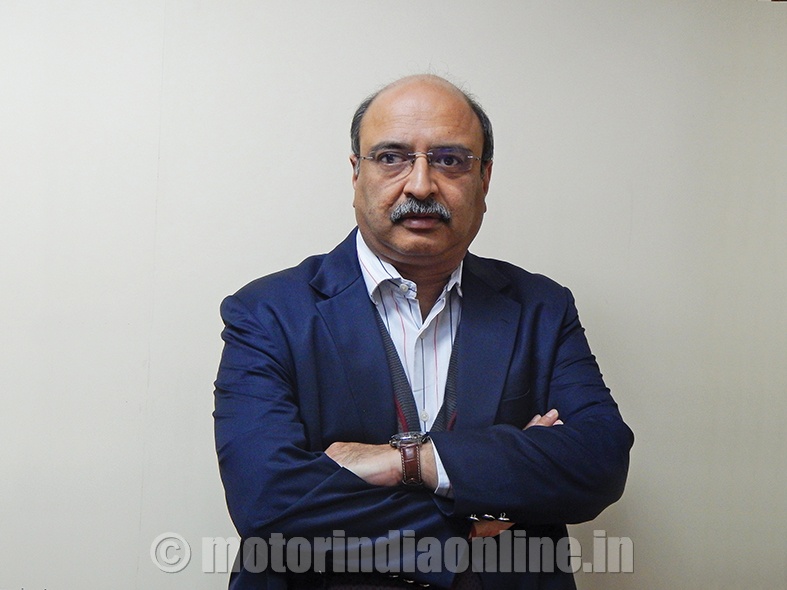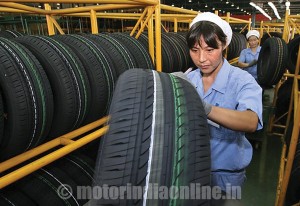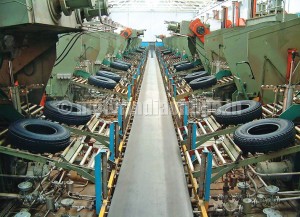
The rate of radialization is actually an index of the status of road development, vehicle engineering and the economy in general. Notwithstanding the problem areas, constraints and limitations, tyre companies have kept pace with the technological improvements that radialization signifies and offer state-of-the-art product (tyres) comparable to the best in the world.
Radialization can be aptly classified as the most important innovation in tyre technology. Despite its several advantages (additional mileage, fuel saving and improved driving) radialization in India earlier did not catch on at a pace that was expected since its introduction way back in 1978. However, the situation has radically changed in recent years as according to Mr. Rajiv Budhiraja, Director-General of Automotive Tyre Manufacturers’ Association (ATMA). In an exclusive interaction with MOTORINDIA, he states that the percentage of CV radialization is expected to increase from 30 per cent to 45 per cent by 2017, though he maintains that tyre-makers will continue to import natural rubber as there is a paucity of high-quality raw material in the country.
Excerpts:
What is ATMA currently doing, besides promoting and safeguarding the interests of the domestic tyre industry?
Yes, ATMA acts as the conduit between Government departments and the tyre industry in India. ATMA projects the views of the industry on various subjects to respective Government departments. It actively participates in the policy and regulation formulation for the tyre industry. Of late, Indian players are expanding overseas and overseas players are setting up a footprint in the country. So in this kind of a scenario, it becomes very important for industry associations like ours looking beyond the borders of the country. That is a new dimension ATMA is looking at.
Has the tyre industry witnessed an improvement in capacity utilisation after the new government assumed power at the Centre?
You have to look at it segment wise. The CV industry was the worst affected during the economic downturn and is still reeling under the ongoing slowdown. On top of that, if there is a marginal improvement, it might appear that the slowdown has bottomed out. But, unfortunately, this segment is still not out of the woods and is yet to see its sales reviving to the level we saw during 2009-10. As a result, the capacities have really not improved. The passenger vehicle industry definitely seems to have bottomed out and we have seen some higher capacity utilisation in that segment. The two-wheeler segment is doing reasonably well, and hence the capacities are improving. For the domestic tyre industry, capacity utilisation has gone down from 85 per cent to around 80 per cent now.
So which segment of the Indian automotive sector is the tyre industry betting big on?
I think CV radial tyre is the segment to watch out for. The domestic TBR industry is currently 28-30 per cent radialised and is  projected to achieve 45 per cent radialization in about three years’ time. Radialization is relatively low in India compared to most markets and its speed is average. But the infrastructure also has to change and has to be fit for radial tyres. Probably in some parts of the countryside, 10-20 years later, bias tyres will still be needed. The future of radialization will be governed by multiple factors such as cost-benefit ratio, road development, overload control, user education and retreading infrastructure.
projected to achieve 45 per cent radialization in about three years’ time. Radialization is relatively low in India compared to most markets and its speed is average. But the infrastructure also has to change and has to be fit for radial tyres. Probably in some parts of the countryside, 10-20 years later, bias tyres will still be needed. The future of radialization will be governed by multiple factors such as cost-benefit ratio, road development, overload control, user education and retreading infrastructure.
The tyre replacement market is also evolving with both domestic and overseas players widening their presence there. So do we see this market getting more organised?
If you are indicating that more tyre companies are adopting their own retail presence than multi-branded outlets, then yes there will be a greater penetration of single brand stores. This is because the companies see a greater value proposition in having said their exclusive retail outlets. This is because it gives them a greater brand visibility as well as a means and a channel to connect with their customers. It also gives them an opportunity and a link to reach out to the customers and explain their new product introductions and technologies. This kind of a personalised experience would be missing in multi-branded outfits.
Having said that, there are some limitations in terms of network which independent dealers are having. There would be such 5,500-6,000 dealers criss-crossing the length and breadth of the country. While companies are moving in that direction, these multi-branded outlets will not be substituted by the franchisee ones. As the market evolves, we will see how things develop. Another interesting trend is that people are following the online retail format. So, with the maturity of the Indian market, I am sure the tyre companies will also evolve and adapt to all the available formats and options for sales & marketing of tyres and related services.
What about the roadside outfits selling retreaded tyres?
The only advantage of buying retreaded tyres from roadside outfits is the cost proposition. If the customer is well-informed about the organised chain of outfits, these fringe players would have a very limited role to play. Moreover, we have seen that an average Indian customer, thanks to the web-based flow of information and availability of smartphones, is increasingly discerning the long-term value derived from the organised market. So a small section of buyers, especially from the truck segment, may continue visiting these unorganised shops. But those who are looking at safety, reliability and durability are happy to shift over to independent or franchisee tyre stores.
Can India be also earmarked as the global export hub for tyres, just like China?
I think that, going forward, this value addition happening in the Indian manufacturing industries is very important. So I am sure this is going to happen in the tyre and other sectors. So, besides the neighbouring countries, there are countries where OEMs are already shipping out their made-in-India vehicles. Africa is a tremendous opportunity (for tyre companies) and is called as the ‘Next Asia’. Then there is Latin America which is the next export destination for our automotive and allied industries. Then there are countries in the Middle East, South-East Asia and the Indian sub-continent which offer a lot of potential for our industry, both automobiles and tyres.
Going forward, will the industry be sourcing its raw material locally?
No, it’s a misnomer to say that India will be having sufficient production of natural rubber to meet our requirements. For the last 7-8 years, we are a deficit in natural rubber because our consumption is much more than the corresponding domestic production. So import of natural rubber is necessary. The volumes of imports are a question mark because there is a lot of inconsistency in NR data that is published.
The second aspect is the quality of natural rubber in the country. This is because as the quality of tyre technologies is getting more complex, truck radialisation is gaining a lot of traction. So this requires raw material which is very top-end and is matching with international standards. But, unfortunately in India, our quality initiatives have not led to the desired outcomes so far. I only hope that things will and should improve.
In order to have healthy completion here, do we expect a blanket ban on import of cheaper Chinese tyres?
I don’t know to what extent is a blanket ban on Chinese tyres feasible. What we feel is that the dumping of sub-standard tyres is rampant in the replacement market. These malpractices are usually resorted to by independent small-time traders and importers. We are fully conscious of this and have raised this issue with the Government and have expressed our concerns. We will be going back to it with more specific inputs and substantive information. We are hopeful that the Government will address this issue as ours is a major industry.
Is the industry going to witness a fresh round of investments in the coming years?
In the last four-five years, the companies have announced investments worth Rs. 25,000 crores. Going forward, they have also announced capacity expansion and growth plans which call for huge investments. This is because our industry is both capital intensive and manpower intensive. So until 2017 we could see that another Rs. 8,000-10,000 crores would be deployed by this industry. Without sharing any specific details, I can confirm that there would be major expansion and perhaps a greenfield project that would be coming up.
So what is the current size of the Indian tyre industry and what are your future projections?
Currently, the size of the Indian tyre industry is Rs. 50,000 crores in terms of turnover, and exports are worth Rs. 10,000 crores. The industry has grown at a pace which is higher than GDP (at 5 per cent). Unfortunately, today we are at a very modest 5-6 per cent growth level because the GDP has itself slowed down. Our industry has witnessed a healthy growth of 8-10 per cent, and we are anticipating that kind of a growth in the future. The size of the industry should double to over Rs. 1 lakh crores in the next five to seven years.
